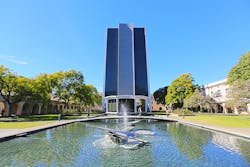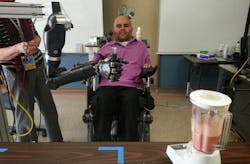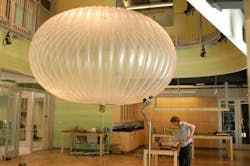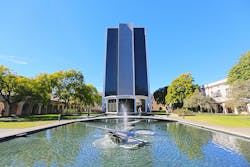Caltech Engineering
Caltech Engineering
This video was created at Caltech to inspire young students (K-12) to think about engineering as a creative, fun, and meaningful career choice that can have enormous positive impact on society. The video was entered into the National Academy of Engineering's "Engineering for You" video contest. At Caltech Engineering, we work at the leading edges of fundamental science to invent the technologies of the future. Here we feature several medical engineering projects currently underway at Caltech: heart pumps and flow, retinal implants, and spinal stimulation to aid paraplegic patients. The video stars our students and postdocs, including a performance by members of one of Caltech's a cappella groups, Out of Context. We aim to capture the vitality, impact, and sheer joy of brilliant engineering.
Controlling a Robotic Arm with a Patient's Intentions
Neural prosthetic devices implanted in the brain's movement center, the motor cortex, can allow patients with amputations or paralysis to control the movement of a robotic limb—one that can be either connected to or separate from the patient's own limb. However, current neuroprosthetics produce motion that is delayed and jerky—not the smooth and seemingly automatic gestures associated with natural movement. Now, by implanting neuroprosthetics in a part of the brain that controls not the movement directly but rather our intent to move, Caltech researchers have developed a way to produce more natural and fluid motions. Read More
Research Centers
Caltech's researchers are known for scientific inquiry that is bold, innovative, and impactful. Because they're allowed to freely explore their best ideas, these investigators are able to further technology, theory, and both fundamental and applied science in more than 30 areas of research.
Cross-disciplinary research centers and institutes support collaborations that develop powerful ideas and move society forward. Read More
Program Overview
Electrical Engineering
Electrical Engineering (EE) at Caltech has an extended record of excellence and innovation. Established in 1910, many distinguished leaders in the field over the last century received their training at Caltech. As a discipline, EE has had a disproportionate and palpable impact on the technologies that define modern-day life and society. EE at Caltech emphasizes both the fundamentals of physical (devices) and mathematical (systems) sides of EE, as well as acknowledging the multi-disciplinary nature of the field. EE has served as the launch pad for and is closely allied with Applied Physics, Bioengineering, Computation and Neural Systems, Computer Science, Control and Dynamical System, and Medical Engineering at Caltech. It offers both undergraduate and graduate students the opportunity for study and research, both theoretical and experimental, in a wide variety of subjects.
Mechanical Engineering
Mechanical and Civil Engineers shape our physical environment from the cities we live in, the machines we use, the way we travel, the energy that powers these to delivering the water we need. An integral part of Caltech for over a century, these disciplines have attracted exceptional individuals and addressed the critical technological challenges of the day. Our particular interests evolve with time, but our core mission of training the leaders of tomorrow and conducting fundamental research to address major technological roadblocks remains constant. Today, you will find students and faculty working on nanostructured fuel cells, study of earthquakes ranging from the source to their impact on buildings, active ferroelectric materials and devices, neural prosthetics, debris flows, response of structures against accidental explosion, water resources, efficient combustion processes, quantum mechanical origins of the strength of materials and design.
Quick Facts
Students (2012-2013)
390 undergraduates
520 graduate
Faculty and Research
Tenured professorial faculty: 76
Non-tenured professorial faculty: 11
Professors Emeriti: 28 Professors: 76
Assistant Professors: 11
Instructors: 2
Senior Research Associates: 3
Senior Research Fellows: 1




